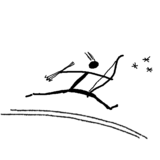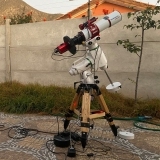INDI Library v2.0.7 is Released (01 Apr 2024)
Bi-monthly release with minor bug fixes and improvements
What means always for resetting guiding calibration
- Wolfgang Reissenberger
-
 Topic Author
Topic Author
- Offline
- Moderator
-

- Posts: 1185
- Thank you received: 370
Replied by Wolfgang Reissenberger on topic What means always for resetting guiding calibration
I personally have very good experience in the combination of EKOS and PHD2 and never had problems with calibrations once calculated. I even re-use calibrations over several nights as long as I am sure that I did not rotate the camera and changed the scope.
But there are several out there that need such re-calibrations. And for those, I would like to set the option such that it makes most sense for them.
Please Log in or Create an account to join the conversation.
- Wolfgang Reissenberger
-
 Topic Author
Topic Author
- Offline
- Moderator
-

- Posts: 1185
- Thank you received: 370
Replied by Wolfgang Reissenberger on topic What means always for resetting guiding calibration
I implemented option 2 - which was quite easy. You can test it here .
Thanks for your quick response!
Wolfgang
Please Log in or Create an account to join the conversation.
Replied by Alfred on topic What means always for resetting guiding calibration
1) "What is expected"? Well, "always" is pretty clear. The normal expectation would be 3.
2) Would that be reasonable and helpful though? No. I agree with Wouter and Jo, 1+2 would be the proper solution. And "always" should be changed to something that doesn't raise wrong expectations. But then,
3) since I would never use this option, don't pay much attention to my opinion.
P.S.: "2 only" is good enough! IMO it doesn't make sense to put that much effort into implementing something that I deem a negligible detail.
Please Log in or Create an account to join the conversation.
- Jose Corazon
-

- Offline
- Supernova Explorer
-

- Posts: 1119
- Thank you received: 182
Replied by Jose Corazon on topic What means always for resetting guiding calibration
With all due respect, it is not a negligible detail if your imaging is dependent upon the scheduler. I agree, if you sit next to your scope, or rather are awake to control the flip and can manually erase the calibration and restart it if necessary, then this becomes a negligible detail. But for those of us who are putting the scope out in the backyard and letting it acquire images fully automatically, it really is an essential feature.
Thanks Wolfgang for putting in the effort! Will test as soon as there is a clear night again.
Jo
Please Log in or Create an account to join the conversation.
Replied by Alfred on topic What means always for resetting guiding calibration
Out of curiosity... if you scheduled a movement in declination once the meridian has been crossed, let's say by pointing the scope to a nearby star and immediately returning to the object, wouldn't that achieve the same?
Please Log in or Create an account to join the conversation.
- Jose Corazon
-

- Offline
- Supernova Explorer
-

- Posts: 1119
- Thank you received: 182
Replied by Jose Corazon on topic What means always for resetting guiding calibration
Ahhh..., Alfred, thanks for bringing that up!
That is precisely the difference between imaging from the middle of Frankfurt and the middle of Dallas....
...well, not really...
But in good old American, I would say 'that's a klutz!'
Which loosely translated into German means something like '' ' ne Kruecke hoch 3".
Here at Indi, we strive for PERFECTION!
Nothing less will do.
That's why nitpickers like me are tolerated here.
I wonder for how much longer...
Anyway, it really will help a lot if you are using the scheduler to fully automate your imaging sessions. That is my main objective here.
Herzliche Gruesse und nimm's mir nicht uebel,
Joachim
Please Log in or Create an account to join the conversation.
- Wolfgang Reissenberger
-
 Topic Author
Topic Author
- Offline
- Moderator
-

- Posts: 1185
- Thank you received: 370
Replied by Wolfgang Reissenberger on topic What means always for resetting guiding calibration
Implementing 1 and 2 turned out to be more complicated, since there are several ways in KStars to slew to a new target and not all are handled the same way.
But during my tests it seems that option 3 isn't that bad, since in a typical workflow slew --> align --> guide it does not matter whether you clear only once or additionally during alignment, since no new calibration has taken place.
OK for you or are there situations where this could be disturbing?
-- Wolfgang
Please Log in or Create an account to join the conversation.
- Wouter van Reeven
-

- Offline
- Supernova Explorer
-

- Posts: 1957
- Thank you received: 420
Replied by Wouter van Reeven on topic What means always for resetting guiding calibration
FYI I only use the internal guider, not PHD2. Unfortunately the weather here in Spain is very bad at the moment so I am afraid there is no way for me to test this, sorry.
Wouter
Please Log in or Create an account to join the conversation.
Replied by alacant on topic What means always for resetting guiding calibration
Hi Wolgang, everyone
Does this affect those of us who guide only with PHD2 in any way?
Here's hoping negative!
Cheers and clear skies to all.
Please Log in or Create an account to join the conversation.
Replied by Alfred on topic What means always for resetting guiding calibration
No worries, alles gut! Using the scheduler doesn't make sense yet in my case as most of the time I drive 100km to a dark place where there is nothing else to do other than to watch my equipment taking pictures. Things like aiming at a new target, re-focusing and such are very welcome things to do. This might change once I have a bed or proper internet connection though.
I would *assume* that re-calibrating after *every* slew during a scheduler session would not increase the total number of re-calibrations very much (compared to the 1+2 solution), if at all.
Please Log in or Create an account to join the conversation.
- Jose Corazon
-

- Offline
- Supernova Explorer
-

- Posts: 1119
- Thank you received: 182
Replied by Jose Corazon on topic What means always for resetting guiding calibration
The intent is that this only comes into play when the box "Always reset guide calibration" is selected. There were cases where this did not happen, although the box was ticked and that would result in the following exposure sequence showing star trails.
So as long as you do not tick that box, nothing should change for you. If you tick the box, recalibration would occur every time the mount slews.
I also need to come back to Wouter's point, though: Would dithering trigger recalibration then, i.e. is dithering handled by the mount the same way slewing is? Intuitively I would say not, because dithering only involves guide pulses, which happen all the time during guiding anyway, so of that were to trigger recalibration, it would effectively start an endless loop. But I want to make sure that this does not become an unintended consequence.
Thanks so much, Wolfgang, for restoring this option.
Please Log in or Create an account to join the conversation.
- Peter Sütterlin
-

- Offline
- Supernova Explorer
-

- Posts: 1009
- Thank you received: 133
Replied by Peter Sütterlin on topic What means always for resetting guiding calibration
Also, what about people with a mount that doesn't report pier side? How do you detect a flip there?
Please Log in or Create an account to join the conversation.
